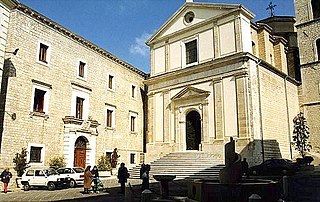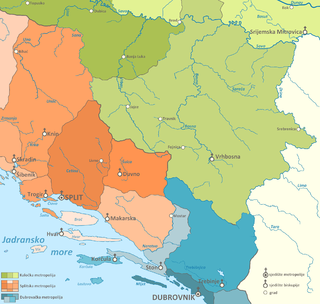
The Portuguese Gold Coast was a Portuguese colony on the West African Gold Coast on the Gulf of Guinea.

The Roman Catholic Diocese of Tui-Vigo is one of the five Latin rite dioceses in the ecclesiastical province of the Metropolitan Archdiocese of Santiago de Compostela, which covers Galicia region in North-western Spain.

The Diocese of Nardò-Gallipoli is a Roman Catholic ecclesiastical territory in southern Italy. It is a suffragan of the Archdiocese of Lecce.

The Roman Catholic Diocese of San Cristóbal de Las Casas is a suffragan diocese of the Archdiocese of Tuxtla. Its see is in San Cristóbal de las Casas in Chiapas. In November 2017 Rodrigo Aguilar Martínez was appointed new bishhop on the resignation of Bishop Felipe Arizmendi Esquivel.

The Italian Catholic Archdiocese of Perugia-Città della Pieve was historically the Diocese of Perugia. It became the Archdiocese of Perugia in 1882, but without suffragans. It acquired suffragan dioceses in 1972. It was united in 1986 with the Diocese of Città della Pieve.
The Italian Catholic diocese of Bertinoro existed from 1360 to 1986. In that year it was united to the diocese of Forlì into the diocese of Forlì-Bertinoro.

The Archdiocese of Potenza-Muro Lucano-Marsico Nuovo is a Roman Catholic ecclesiastical territory in Basilicata, southern Italy, created in 1986. In that year the Diocese of Muro Lucano was united into the Archdiocese of Potenza e Marsico Nuovo, which had been elevated to an archdiocese in 1973, and made a metropolitan see in 1976. The historical Diocese of Potenza was united with the Diocese of Marsico Nuovo in 1818. The joint diocese was then a suffragan of the Archdiocese of Salerno.

The Roman Catholic Diocese of Calahorra y La Calzada-Logroño is a diocese located in the cities of Calahorra, Santo Domingo de la Calzada, and Logroño in the Ecclesiastical province of Pamplona y Tudela in Spain.

The Roman Catholic Diocese of Zamora is a diocese in the city of Zamora in the Ecclesiastical province of Valladolid in Spain.
The Roman Catholic Diocese of Santorini is a diocese located in the city of Santorini in the Ecclesiastical province of Naxos, Andros, Tinos and Mykonos in Greece.

The Roman Catholic Archdiocese of Cartagena is an archdiocese located in the city of Cartagena in Colombia.
The former Italian Catholic diocese of Alatri existed until 1986, when it was united into the diocese of Anagni-Alatri. Comprising historically seven towns close to Rome, it was under the immediate jurisdiction of the Holy See.

Diocese of Nusco was a Roman Catholic ecclesiastical territory in Campania, southern Italy, existing until 1986. In that year it was united into the archdiocese of Conza-Sant'Angelo dei Lombardi-Bisaccia, to form the Archdiocese of Conza-Sant'Angelo dei Lombardi-Nusco-Bisaccia. It was a suffragan of the archdiocese of Salerno.
The Diocese of Isola was a Roman Catholic diocese in Italy, located in Isola di Capo Rizzuto, Crotone, Reggio Calabria in the ecclesiastical province of Santa Severina.

The Diocese of Ston was a Roman Catholic diocese in Croatia, located in the city of Stagno. In 1828, it was suppressed to the Archdiocese of Dubrovnik.
The Diocese of Levello was a Roman Catholic diocese in southern Italy, located in the city of Lavello, province of Potenza, in the region of Basilicata. In 1818, it was suppressed, and its territory and members incorporated in the Diocese of Venosa.
The Roman Catholic Diocese of Capri was a Roman Catholic diocese located in the city of Capri on the island of Capri, in the Tyrrhenian Sea off the Sorrentine Peninsula, on the south side of the Gulf of Naples in the Campania region of Italy. On 27 June 1818, it was suppressed to the Archdiocese of Sorrento.
The Diocese of Polignano or Diocese of Polinianum was a Roman Catholic diocese located in the town of Polignano in the province of Bari, Apulia, southern Italy, located on the Adriatic Sea. In 1818, it was suppressed to the Diocese of Monopoli. It was restored as a Titular Episcopal See in 1968.
Antonius Serra was a Roman Catholic prelate who served as Bishop of Milos (1642–1669).














